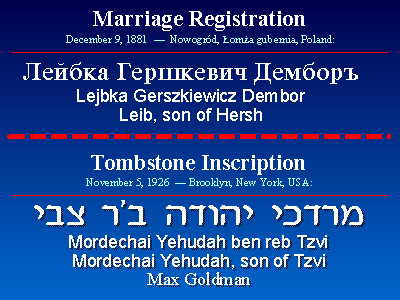Example Revisited
Slide 47 of 94



Returning to the example at the beginning of this lecture, we can now begin
to understand why "Lejbka Gerszkiewicz" (the Yiddish name of a Polish Jew written
in Russian) and "Mordechai Yehudah ben Tzvi" (Hebrew) are the same person.
This is an excellent example of some of the challenges of Jewish genealogical
research, where names are written in many languages and alphabets. In this one
example we have five languages in three alphabets. This is the reality of
Jewish genealogical research. Here we see the use of:
- Unrelated Double Names: Mordechai and Yehudah.
Both names were used on the tombstone, in other sources only one name was used.
- Related Names, Biblical Association: Yehudah and Leib.
The Hebrew name was used on the tombstone; its Yiddish kinnui Leib was used
in the civil record.
- Related Names, Hebrew/Yiddish Calque: His father's name
is given in Hebrew on the tombstone, Tzvi; its Yiddish calque Hersh was used
in the civil record.
- Patronymics, in Russian and Hebrew.
"Gerszkiewicz" = son of Gershka; "ben Tzvi" = son of Tzvi.
- The Russian H: The Yiddish H in "Hersh" becomes a G in
Russian.
- Diminutives: The Slavic suffix "-ka" turns Leib into Leibka,
and Gersh into Gershka.
The English given name which he used in America, Max, was based upon the initial
letter of one of his Hebrew given names, Mordechai.

